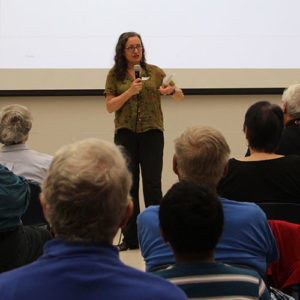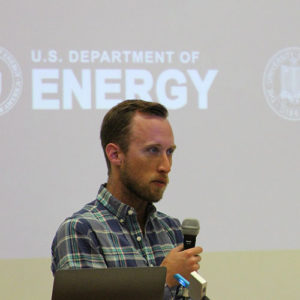American Chemical Society event features talks, plaque rededication recognizing element discoveries

Two Berkeley Lab scientists participated in an Aug. 11 event at the Lawrence Hall of Science that honored the Lab’s contributions to the periodic table and celebrated the 150th anniversary of the periodic table of elements.
The event, organized by the American Chemical Society, featured the rededication of a plaque to commemorate the role of Berkeley Lab and its scientists in the discovery of elements heavier than uranium.
The event also included a presentation by David Seaborg, an evolutionary biologist and environmental advocate, that highlighted the contributions of his father, Berkeley Lab nuclear chemist and Nobel Laureate Glenn T. Seaborg, to these element discoveries.
Duplicate plaques will be placed at Berkeley Lab and at the Lawrence Hall of Science. (View the plaque text here.)
Berkeley Lab scientists played a role in the discovery of 16 elements, including elements 93 (neptunium) through 106 (seaborgium), and in the reorganization of the periodic table that was created 150 years ago by Russian chemist Dmitri Mendeleev.
“Berkeley Lab researchers’ production and discovery of new elements and isotopes has opened up new fields in medical imaging and treatments, and enabled a richer understanding of the fundamental properties of atomic nuclei,” Berkeley Lab Director Michael Witherell said in a statement.
“We are honored to be recognized for our pioneering efforts in expanding the periodic table of elements and expanding our knowledge of these exotic elements. Our ongoing studies of these elements are still yielding new information and inspiring ideas for practical applications,” he added.
 Frances Hellman (left), a senior faculty scientist in Berkeley Lab’s Materials Sciences Division and dean of the Division of Mathematical and Physical Sciences at UC Berkeley who was one of the first speakers during the event, said the periodic table provides a vital framework for understanding materials.
Frances Hellman (left), a senior faculty scientist in Berkeley Lab’s Materials Sciences Division and dean of the Division of Mathematical and Physical Sciences at UC Berkeley who was one of the first speakers during the event, said the periodic table provides a vital framework for understanding materials.
If the periodic table did not exist, she said, “How I would look at all the minerals around me and do anything with that information is just astonishing. I don’t even know how I would start.”
The contributions of UC Berkeley and Berkeley Lab to element discoveries and R&D has “been a remarkable evolution,” she added. “UC Berkeley and (Berkeley Lab) are very, very proud partners in all of that. It was a tribute to that partnership that we are here today, and the discovery of those elements … was a tribute to the partnership between physics and chemistry.”
Korey Carter (right), a postdoctoral researcher in the BioActinide Chemistry Group at Berkeley Lab’s Glenn T. Seaborg Center who also spoke during the event, shared the latest research by his group in finding ways to quickly cleanse highly radioactive elements from the body, and in finding new medical treatments that rely on targeted radiation supplied by specialized forms of heavy elements.
 “The way this works is to … attach an antibody (to the isotope), which can find the tumor cell. And you use the radiation that’s intrinsic for the (isotope) to more selectively kill cancer cells or potentially even antibiotic-resistant bacteria,” Carter said.
“The way this works is to … attach an antibody (to the isotope), which can find the tumor cell. And you use the radiation that’s intrinsic for the (isotope) to more selectively kill cancer cells or potentially even antibiotic-resistant bacteria,” Carter said.
While there is still a lot of chemistry in development to support this kind of treatment, dubbed alpha-particle therapy, he added, “The reason we spend a lot of time on this is because we know it works.”
David Seaborg reflected on his father’s sudden spark of interest in science in high school that led him to a successful career in chemistry that included participation in 10 element discoveries, a Nobel Prize, and the realization of a once-disputed theory on how to order newly discovered elements in the periodic table.
“His mother wanted him to be a bookkeeper – she thought that’s the best he could do,” Seaborg said. But in high school in Watts, California, a chemistry teacher “preached chemistry – he didn’t just teach it. He told amazing stories.”
He added, “It’s a great story of how teachers can affect the lives of people, because that’s what got my Dad interested in chemistry.”
Glenn Seaborg’s successful reorganization of the periodic table, David said, was his father’s proudest achievement, “more so than the discovery of plutonium.” Another notable achievement was his father’s discovery of an isotope of iodine, called iodine-131, that ultimately was key in saving the life of Glenn Seaborg’s mother, who suffered from thyroid problems.
David Seaborg also shared a decisive moment in his father’s career – when he chose to remain in Berkeley over an offer at UCLA. “To him it was just magic, all the great scientists (in Berkeley),” Seaborg said.